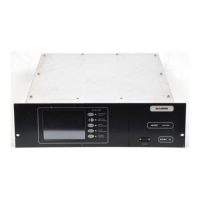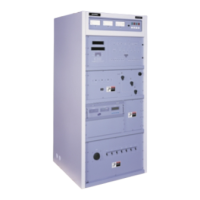LOW “Inverted Turn-on Pulse” is generated at the Q-not
output and generates a “Data Strobe” signal for the Analog
Input Board data latches.
d. K1 HAS CLOSED. When K1 closes, an auxiliary contact
places a +30 Vdc signal at the input of a de-bounce and
logic level converter circuit Q10-8 and U59-6. U59-6 is a
“K1 Has Closed-H” signal which:
1. Resets “Underdrive Inhibit-B”. Resets the underdrive
comparator reference, on the LED Board.
2. Starts a 0.3 second delay timer R96/C90.
e. K1 HAS CLOSED + 0.3 SECONDS. Approximately 0.3
seconds after the “K1 Has Closed-H” signal, delay timer
circuit U59-12 provide a logic HIGH output which:
1. Releases “Underdrive Inhibit-A”. The logic HIGH in-
put to U51-4 forces the output HIGH and activates the
underdrive fault circuit on the LED Board.
2. Starts a 0.8 second delay timer R65/C94. The output of
the second timer is a “K1 HAS CLOSED + 1.1 SEC-
ONDS” logic HIGH signal.
f. K1 HASCLOSED +1.1 SECONDS.The0.8second delay
logic HIGH output occurs (0.3 + 0.8) 1.1 seconds after the
“K1 Has Closed” input. This logic HIGH signal:
1. Generates a “K2 DRIVE” signal. The logic HIGH
signal feeds OR gate U51-1, K2 Inhibit gate U53-5,
Supply Fault gate U53-9 and K2 Drive transistor Q10-
7. If no “INHIBIT K2-L” fault signal is present at K2
inhibit gate U53-6 and no “SUPPLY FAULT-L” fault
signal is present at U53-8,theK2Drivesignal energizes
step-start contactor K2.
2. Generates a “RELEASE INHIBIT-H” signal, at U51-3,
which enables the power control.
g. K2 HAS CLOSED. When K2 closes, a +30 Volt logic
signal from the auxiliary contact is fed to the de-bounce
and logic level converter circuits Q10-14 and U59-3. The
output from the converter, a “K2 HAS CLOSED-H” sig-
nal:
1. Latches K2. If no faults are present, the “K2 HAS
CLOSED-H” pin 1 input to OR gate U51 holds the
gate’s output HIGH, and latches K2.
2. Inhibits a new Turn-On Pulse. Inhibits U56A via pin 1,
so that another power mode change (which generates
another “TURN-ON REQUEST”) cannot trigger an-
other Turn-On Pulse.
3. Startsa 150millisecond delay timer.After 150 millisec-
onds, U59-10 output goes from HIGH to LOW.
4. Releases “OVERDRIVE INHIBIT-L”.The“OVER-
DRIVE INHIBIT-L” is released through U52-6 so that
rf overdrive sensing circuits and air flow fault circuits
ontheLEDBoardareallowedtooperate.
5. Turns the PA Modules ON. The “PA OF F-L” signal
from U53-3 goes HIGH, which turns the PA Modules
ON.
h. At this time, approximately 1.2 seconds has elapsed since
the “TURN-ON REQUEST”, and the transmitter is “ON.”
The 1.6 second “K1 TURN-ON” pulse will continue to
remain HIGH for approximately 0.4 seconds, then it will
go LOW, K1 Drive will be removed, and K1 will de-ener-
gize.
P.4.1.2 Transmitter Turn-off Sequence
When the “OFF” button is depressed, the HIGH, MEDIUM or
LOW light goes out, contactor K2 de-energizes, and power
output drops to zero. A remote “OFF” command, a Type 1 Fault
or Type 2 Fault induced “OFF” command causes the same circuit
action as depressing the OFF button.
When a latched “OFF-H” signal is received from the power
control logic, the following sequence takes place:
a. De-energizes K2. The “OFF-H” signal at U52-2 generates
the “INHIBIT K2-L” signal. The “INHIBIT K2-L” signal:
1. Turns OFF PA Power Supply. The logic LOW input at
U53-5 inhibits the K2 Drive signal and K2 de-ener-
gizes, removing primary power from the PA Power
Supply. The K2 drive signal is inhibited as long as the
latched “OFF” command is present.
2. Inhibits “TURN-ON REQUEST”. The signal goes to
the Power Control logic to prevent a “TURN-ON RE-
QUEST” as long as the latched “OFF” command is
present.
3. Inhibits Overdrive and Air Flow Fault Sensing. The
output of U52-6 goes LOW to inhibit the overdrive and
air flow sensing circuits when the PA Modules are
turned OFF.
4. Turns PA Modules OFF. The output of U53-3 goes
LOWto generate a “PA OFF-L” command to the power
amplifier. The PA is held OFF as long as the latched
“OFF” command is present.
b. When K2 de-energizes its auxiliary contact opens and the
“K2 IS CLOSED-H” line goes LOW. This causes the
following circuit actions:
1. Removes K2 Latching Signal. The “K2 IS CLOSED-
H” input to U51-2 goes LOW. K2 cannot energizeagain
until another “TURN-ON REQUEST” starts the turn-
on sequence again.
2. Inhibits Power Change. The output of gate U51-3 goes
LOW, removing the “Release Inhibit-H” signal and
inhibiting the power change circuitry.
3. Holds PA OFF. The U59-10 delay circuit and gates
U52-6 and U53-3 generate the “PA OFF-L” signal until
K2 energizes again.
4. Inhibits Air Flow and Overdrive Fault Sensing. The
U59-10 delay circuit and U52-6 generate the “OVER-
DRIVE INHIBIT-L” signal.
5. Inhibits Underdrive Fault Sensing. The U51-6 gate
generates the “UNDERDRIVE INHIBIT A” signal.
6. Removes Turn-On Pulse Inhibit. The output of U54-6
goes LOW to allow U56-13 to generate a turn-on pulse
when the “OFF” command is removed and a “TURN-
ON REQUEST” is generated.
DX-25U
P-2 888-2297-002 Rev. S: 05-02-97
WARNING: Disconnect primary power prior to servicing.
